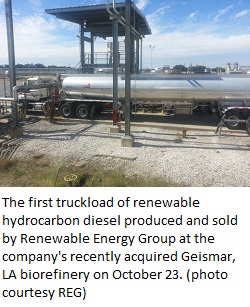 CNG Source will open its first Indianapolis CNG station on November 20, 2014. The four-lane facility is the first public station the company has branded with the CNG Source name, and it features the latest advancements within the compressed natural gas industry, including CNG Source’s proprietary fast fill technology which allows for the dispensing of twelve gallons per minute. The station is located next to the triangle formed by the I-465, Brookville road and Shadelan Ave.
CNG Source will open its first Indianapolis CNG station on November 20, 2014. The four-lane facility is the first public station the company has branded with the CNG Source name, and it features the latest advancements within the compressed natural gas industry, including CNG Source’s proprietary fast fill technology which allows for the dispensing of twelve gallons per minute. The station is located next to the triangle formed by the I-465, Brookville road and Shadelan Ave.- Four Dutch and German consultancies in the field of offshore renewable energy have teamed up and established a new international consultancy company Wind Minds with the objective to combine all their expertise and experience in developing and building new offshore wind farms in North West Europe, America and Asia. One of their first targets are Japan and Korea, countries being visited when Wind Minds joins the trade mission of Dutch Minister of Economic Affairs Henk Kamp, between October 27th and November 4th. This mission accompanies King Willem Alexander and Queen Maxima during their state visit to both countries.
- SunEdison, Inc. has signed a Memorandum of Understanding (MOU) with the Rajasthan Government aimed at developing Rajasthan as the global hub for solar energy. SunEdison intends to establish 5 GWs of capacity in the form of multiple Mega Solar Projects, with the expected capacity of each Mega Solar project 500 megawatts (MW) or more. The MOU comes at an opportune time following the new Solar Policy announced by the Government of Rajasthan, which aspires to create 25 GW of solar capacity in the state in the next few years.
- Construction has begun on the Armow Wind power project in Ontario. Samsung Renewable Energy, Inc. and Pattern Energy Group LP have announced the completion of a C$580 million construction and term loan financing, which was secured with 10 financial institutions. Located in the Township of Kincardine, the 180 MW Armow Wind power project will utilize more than 200 Ontario workers and Ontario-made products, including 91 wind turbine towers made in Windsor and 273 blades manufactured in Tillsonburg.
ONR Expands Green Reach in Asia-Pacific
The Office of Naval Research (ONR) is expanding its work in Asia-Pacific’s renewable energy sector. The announcement was made during National Energy Action Month where the Navy is promoting energy efficiency and conservation by participating in and hosting events around the world. The announcement comes after ONR’s work with the Chiang Mai World Green City that was established two years ago at Chiang Mai Rajabhat University with support from ONR. It uses solar cells, batteries for energy storage and a direct-current (DC) microgrid to power more than 20 buildings over 200 acres, including residences, offices, businesses and a vegetable farm.
 “Each new partnership we establish moves the United States and our allies closer to energy independence,” said Dr. Richard Carlin, head of ONR’s Sea Warfare and Weapons Department. “This system is unique in that it uses direct current to power an entire community. While this concept is perfect for isolated and remote communities, it also could be used in the future on naval installations and even ships at sea to bring power to our Sailors and Marines wherever they are.”
“Each new partnership we establish moves the United States and our allies closer to energy independence,” said Dr. Richard Carlin, head of ONR’s Sea Warfare and Weapons Department. “This system is unique in that it uses direct current to power an entire community. While this concept is perfect for isolated and remote communities, it also could be used in the future on naval installations and even ships at sea to bring power to our Sailors and Marines wherever they are.”
Scientists in Thailand plan to establish another smart grid-powered village at the University of Phayao and introduce sustainable technologies to military barracks and other communities throughout the country.
ONR now has turned its attention to Vietnam, where there is an abundance of solar, biomass, wind, geothermal, hydro and other rich renewable energy sources. The U.S.-Vietnam collaboration also will take advantage of investments made in Hawaii, where ONR is sponsoring a study of electrical grids for three naval bases. As part of that initiative, the Hawaii Natural Energy Institute (HNEI) and the Applied Research Laboratory at the University of Hawaii are working with the Naval Facilities Engineering Command to develop an action plan for the Navy’s energy needs in Hawaii.
“We are expanding our research collaboration to Vietnam to build off the success in Thailand and to support the United States in our pivot to the Asia-Pacific region,” said Dr. Cung Vu, ONR Global associate director for power and energy. “Vietnam’s remote rural, mountainous and island areas will benefit from ONR’s microgrid research, and the Navy will be able to increase its understanding of energy-efficient technologies through another key partnership.”
Energy Fuels Big Year for GROWMARK
![]() Energy was a big reason that regional cooperative GROWMARK had such a big year this year. This company news release says Fiscal Year 2014 was in the top five income years in company history, and a lot of the credit goes to record volumes in the company’s propane and biofuels business.
Energy was a big reason that regional cooperative GROWMARK had such a big year this year. This company news release says Fiscal Year 2014 was in the top five income years in company history, and a lot of the credit goes to record volumes in the company’s propane and biofuels business.
 Marshall Bohbrink, vice president and chief financial officer, reported record sales of $10.4 billion; consolidated pretax income of $194 million; and total patronage in the amount of $112 million will be returned to GROWMARK member-owners.
Marshall Bohbrink, vice president and chief financial officer, reported record sales of $10.4 billion; consolidated pretax income of $194 million; and total patronage in the amount of $112 million will be returned to GROWMARK member-owners.
“GROWMARK is in extremely strong financial condition and we are well positioned in the event the Ag economy is more challenging in the next few years,” said Bohbrink.
Key highlights of FY2014 operational results include:
GROWMARK Energy reported record fuel volume with an increase in gasoline and distillate sales of 11% and an increase of 29 percent in propane gallons.
REG Sells First Gallons of Renewable Diesel from La. Plant
 Biodiesel behemoth Renewable Energy Group, Inc. (REG) rolled out the first commercial-scale quantities of renewable diesel from its Geismar, Louisiana biorefinery. This company news release says that fuel is now available for sale.
Biodiesel behemoth Renewable Energy Group, Inc. (REG) rolled out the first commercial-scale quantities of renewable diesel from its Geismar, Louisiana biorefinery. This company news release says that fuel is now available for sale.
The first truckloads of REG-9000™/RHD produced at the 75-million gallon nameplate biorefinery since REG acquired it in June left the plant October 23. The advanced biofuel from REG Geismar, located south of Baton Rouge, meets or exceeds ASTM D975 specifications.
“We are pleased to be offering REG-9000/RHD for sale,” said Daniel J. Oh, REG President and CEO. “REG-9000/RHD is a new addition to our fuel product line-up designed to serve our customers’ needs for great fuel that also delivers towards our nation’s energy diversity, environmental and food security goals.”
Iowa-based REG is one of the nation’s biggest producers of biofuels, with 10 active biorefineries across the country and a developer of renewable chemicals.
ACE Thanks Motorclubs’ Endorsement of E15
Gene Hammond and Mark Muncey, co-owners of Travelers Motor Club and Association Motor Club Marketing have endorsed E15 (15 percent ethanol and 85 percent petroleum in motor gasoline). American Coalition for Ethanol (ACE) Senior Vice President Ron Lamberty thanked the motorclubs, who have members in all 50 states, for setting the record straight on E15.
Hammond, who has worked in the auto club business for 40 years said, “Not one of our over 18 million members has called us with a problem related to the new E15 fuel or any  ethanol blend. Travelers Motor Club and Association Motor Club Marketing support the use of E15 in vehicles as a safe and affordable alternative to gasoline.”
ethanol blend. Travelers Motor Club and Association Motor Club Marketing support the use of E15 in vehicles as a safe and affordable alternative to gasoline.”
Lamberty called it “eerily appropriate” for the auto clubs to speak out so close to Halloween. “Ethanol opponents have done a masterful job of devising E15 horror stories, and we appreciate these two motor clubs shining the light on the campaign being waged by Big Oil and AAA, and showing drivers that the E15 monsters aren’t real.”
“Real-world results trump ghost stories, and the real-world findings of these two auto clubs mirror what we have heard from fuel station owners who sell E15: they’ve had no customer complaints, no breakdowns, and no repair bills from drivers who fill-up with E15,” continued Lamberty. “In fact, because E15 is a higher-octane fuel that costs less than regular, stations with E15 are gaining customers and E15 has become the second highest volume fuel in most of the stations that sell it.”
Lamberty said the motor clubs’ announcement, coupled with last week’s U.S. Court of Appeals ruling rejecting an E15 lawsuit filed by Big Oil, automakers, and the small engine lobby, “offers hope that truth will win out over fear-mongering”.Read More
Export Exchange Tours Build Relationships
 Many of the international teams visiting the United States last week for the 2014 Export Exchange also participated in tours before and after the event to see ethanol plants and farms across the Midwest.
Many of the international teams visiting the United States last week for the 2014 Export Exchange also participated in tours before and after the event to see ethanol plants and farms across the Midwest.
Badger State Ethanol in Wisconsin had the honor of hosting a team of buyers from the Kingdoms of Saudi Arabia and Jordan. The KSA/Jordan team included companies representing the major dairy and poultry companies and major importers of feed grains in both countries and have been buyers of DDGS in the last couple of years.
 Held every other year by the U.S. Grains Council (USGC) and the Renewable Fuels Association (RFA), Export Exchange brings together more than 200 international buyers with U.S. sellers of corn, sorghum, barley, distiller’s dried grains with solubles (DDGS), corn gluten meal and corn gluten feed. Over the course of three days of events and the pre- and post-tours, these individuals not only do business directly but also make connections to facilitate future sales.
Held every other year by the U.S. Grains Council (USGC) and the Renewable Fuels Association (RFA), Export Exchange brings together more than 200 international buyers with U.S. sellers of corn, sorghum, barley, distiller’s dried grains with solubles (DDGS), corn gluten meal and corn gluten feed. Over the course of three days of events and the pre- and post-tours, these individuals not only do business directly but also make connections to facilitate future sales.
“This year’s Export Exchange was a resounding success,” said RFA president Bob Dinneen, pictured here with USGC president Tom Sleight. “In addition to new business agreements, it is my hope that attendees from all across the world will return home with a better understanding of international grain markets, domestic supply and demand of DDGS and coarse grains, and the current political landscape.”
Renewables Continue to Gain Ground
Renewables continue to gain ground according to the latest “Energy Infrastructure Update” report renewable energy sources including biomass, geothermal, hydropower, solar and wind, account for more than 40.61 percent of all new U.S. electrical generating capacity installed during the first nine months of 2014. Only natural gas provided more new generating capacity. The report was published by the Federal Energy Regulatory Commission’s Office of Energy Projects (FERC).
 New capacity in 2014 from the combination of renewable energy sources is nearly 35 times that of coal, oil and nuclear combined (3,598 MW vs. 104 MW). When looking at just September, renewable energy sources accounted for 2/3 of the 603 MW of new generating capacity put in service (367 MW of wind/60.8% plus 41 MW of solar/6.8%).
New capacity in 2014 from the combination of renewable energy sources is nearly 35 times that of coal, oil and nuclear combined (3,598 MW vs. 104 MW). When looking at just September, renewable energy sources accounted for 2/3 of the 603 MW of new generating capacity put in service (367 MW of wind/60.8% plus 41 MW of solar/6.8%).
Of the 8,860 MW of new generating capacity from all sources installed since January 1, 2014, 187 “units” of solar accounted for 1,671 MW (18.86%), followed by 28 units of wind 1,614 MW (18.22%), 7 units of hydropower 141 MW (1.59%), 38 units of biomass 140 MW (1.58%), and 5 units of geothermal 32 MW (0.36%). The balance came from 41 units of natural gas 5,153 MW (58.16%), 1 unit of nuclear 71 MW (0.80%), 11 units of oil 33 MW (0.37%), and 6 units of “other” 7 MW (0.08%). There has been no new coal capacity added thus far in 2014.
Comparing the first nine months of 2014 to the same period in 2013, new generating capacity from renewable energy sources grew by 11.8 percent (3,598 MW vs. 3,218 MW). Renewable energy sources now account for 16.35 percent of total installed operating generating capacity in the U.S. – up from 15.68 percent a year earlier: water – 8.45 percent, wind – 5.35 percent, biomass – 1.38 percent, solar – 0.84 percent, and geothermal steam – 0.33 percent. Renewable energy capacity is now greater than that of nuclear (9.23%) and oil (3.97%) combined.
“The steady and rapid growth of renewable energy is unlikely to abate as prices continue to drop and the technologies continue to improve,” commented Ken Bossong, executive director of the SUN DAY Campaign. “The era of coal, oil, and nuclear is drawing to a close; the age of renewable energy is now upon us.”
SEIA Launches Campaign to Extend Solar Tax Credits
The Solar Energy Industries Association (SEIA) has launched a national campaign designed to get Congress to extend the 30 percent solar  Investment Tax Credit (ITC) beyond 2016. The campaign focuses on ‘tax fairness’. SEIA President and CEO Rhone Resch announced the campaign during the opening session of Solar Power International (SPI). The campaign will begin in full stream in 2015, when a new Congress is sworn in.
Investment Tax Credit (ITC) beyond 2016. The campaign focuses on ‘tax fairness’. SEIA President and CEO Rhone Resch announced the campaign during the opening session of Solar Power International (SPI). The campaign will begin in full stream in 2015, when a new Congress is sworn in.
“Since the United States first began incentivizing energy development, the average annual subsidy has been $4.8 billion for oil and gas, compared to just $370 million for all renewable technologies,” Resch said. “How is this fair? How is this a leveling playing field? How does this kind of policy support an ‘all-of-the-above’ energy policy? Simply put, it doesn’t.”
Since the ITC went into effect in 2006, solar investment has exponentially grown. According to Resch, Solar installations in 2014 will be 70 times higher than they were in 2006, and by the end of this year, there will be nearly 30 times more installed solar capacity. There are also more than 143,000 Americans currently employed in solar.
“We’ve gone from being an $800-million industry in 2006 to a $15-billion industry today,” added Resch. “The price to install a solar rooftop system has been cut in half, while utility systems have dropped by 70 percent. It’s taken the U.S. solar industry 40 years to install the first 20 gigawatts (GW) of solar. Now, we’re going to install the next 20 GW in the next two years. And finally, during every single week of this year we’re going to install more capacity than what we did during the entire year in 2006. Tell me that’s not worth fighting for.”
EU Leaders Lack Climate & Energy Leadership
According to several organizations, although European Union Heads of State agreed upon a climate and energy framework, it fails to provide industrial leadership for Europe. Both Ocean Energy Europe (OEE) and the European Wind Energy Association (EWEA) criticized the plan. OEE said the new greenhouse gas emission targets, renewable energy and energy efficiency will do little to capitalize on the security, employment and export potential of new energy sectors including ocean, wind and offshore wind energy. The groups argue the framework put Europe’s future energy security and the country’s position as a global renewable energy and climate leader at risk.
The European Council agreed to a 40 percent binding greenhouse gas emission reduction target, a 27 percent binding, EU-wide renewable energy target, and a 27 percent non-binding, EU-wide energy efficiency target.
 “If the EU is serious about tackling big issues such as energy security, unemployment and climate change, it needs to provide industrial leadership on climate and energy by setting hard and fast targets and reduce its exposure to highly volatile fossil fuel imports,” said Dr Sian George, CEO of Ocean Energy Europe. “Economies across the world will have to transition to low-carbon. By staying ahead of this curve, Europe can tap into massive export and job creation potential. This is as true for the first generation of renewable energy as it will be for the next generations, such as ocean energy technologies.”
“If the EU is serious about tackling big issues such as energy security, unemployment and climate change, it needs to provide industrial leadership on climate and energy by setting hard and fast targets and reduce its exposure to highly volatile fossil fuel imports,” said Dr Sian George, CEO of Ocean Energy Europe. “Economies across the world will have to transition to low-carbon. By staying ahead of this curve, Europe can tap into massive export and job creation potential. This is as true for the first generation of renewable energy as it will be for the next generations, such as ocean energy technologies.”
In 2009, Europe agreed to climate and energy targets for 2020 helping to bring first-gen renewable energy industries to market in part due to market certainty. The new targets need to be higher, said George, for renewables to move into second generation renewable energy technologies.
Thomas Becker, chief executive officer of the European Wind Energy Association, said the lower unenforceable targets create market uncertainty and for the wind industry this “clarity” is critical to investors who rely on long-term policies to provide stability.
“The interconnectivity target is bewildering given the current political challenges Europe is facing. We’re in the midst of an energy crisis with Russia holding Member States to ransom over gas supplies,” said Becker. “Yet Heads of State see fit to trot out a meaningless target that will do nothing to improve connection in the Iberian Peninsula or the security of supply in the Baltic States, let alone allow an internal energy market to develop. On GHG reduction, this weakens the position of the EU for the climate talks in Paris next year,” added Becker. “I can’t understand how Member States are going to reach this target and who is guaranteeing that this is not just an empty shell. I can assure you that the other climate negotiators are very good at finding the holes in the cheese.”
BioEnergy Bytes
 ICM, Inc. has announced that the United States District Court for the Southern District of Indiana issued a sealed order on October 23, 2014 holding all asserted GS CleanTech’s corn oil separation patents invalid and not infringed.
ICM, Inc. has announced that the United States District Court for the Southern District of Indiana issued a sealed order on October 23, 2014 holding all asserted GS CleanTech’s corn oil separation patents invalid and not infringed.- Magic Dirt, an organic peat moss replacement and byproduct of DVO’s anaerobic digestion (AD) process, won the 2014 Bioproduct Innovation of the Year Award from the Bioproducts World Showcase and Conference.
- Driven by increasing annual installations, the global capacity of wind turbines using gearboxes is set to rise from approximately 27 Gigawatts (GW) in 2013 to 44.7 GW by 2020, according to research and consulting firm GlobalData. The report states that China overtook the US in 2009 to become the largest wind power market globally in terms of annual capacity additions, and has since taken the lead in wind turbine deployment.
- Worthington Industries, Inc. has acquired a majority interest in dHybrid Systems, a leader in compressed natural gas (CNG) fuel systems. Worthington will own 80% of the with the founder retaining 20% and continuing in a leadership role.

